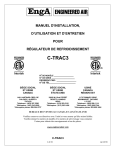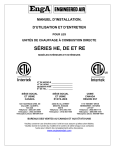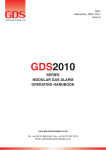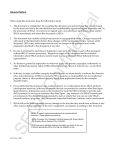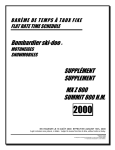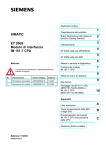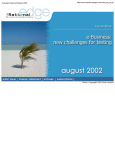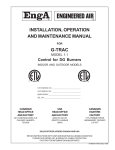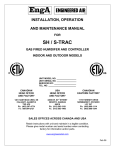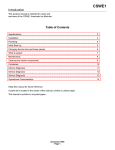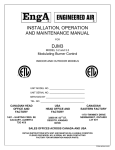Download Installation, Operation and Maintenance Manual
Transcript
A INSTALLATION, OPERATION AND MAINTENANCE MANUAL FOR PACK SERIES INDIRECT GAS FIRED HEATING UNITS INDOOR AND OUTDOOR MODELS C LIST E D LIST E D R R UNIT MODEL NO. ______________________________ UNIT SERIAL NO. ______________________________ SERVICED BY: __________________________________ TEL. NO: ______________________________________ CANADIAN HEAD OFFICE AND FACTORY CANADIAN EASTERN FACTORY 1401-HASTINGS CRES. S.E. CALGARY, ALBERTA T2G-4C8 1175-TWINNEY DRIVE NEWMARKET, ONTARIO L3Y-5V7 SALES OFFICES ACROSS CANADA AND USA RETAIN INSTRUCTIONS WITH UNIT AND MAINTAIN IN A LEGIBLE CONDITION PLEASE GIVE MODEL NO. & SERIAL NO. WHEN CONTACTING FACTORY FOR INFORMATION AND/OR PARTS FORM #PACK-8.99 INSTALLATION, OPERATION AND MAINTENANCE MANUAL INDEX PAGE INTRODUCTION ............................................................................................................. 2 WARRANTY ................................................................................................................... 2 RECEIVING THE UNIT ................................................................................................... 3 INSTALLATION CODES ........................................................................................................................... 3 CLEARANCES ................................................................................................................ 3 LIFTING THE UNIT ......................................................................................................... 4 MOUNTING THE UNIT.................................................................................................... 4 DRAIN TRAPS ................................................................................................................ 4 ASSEMBLING THE UNIT ................................................................................................ 5 VENTING PRODUCTS OF COMBUSTION...................................................................... 5 GAS INSTALLATION ...................................................................................................... 6 ELECTRICAL INSTALLATION ........................................................................................ 6 START-UP CHECK LIST................................................................................................. 7 OPERATION OPERATIONAL CHECK ................................................................................................. 8 ELECTRODE DETAIL ................................................................................................... 10 UNIT SHUT-DOWN INSTRUCTIONS ............................................................................ 10 (A) SERVICE SHUT-DOWN......................................................................... 10 (B) EMERGENCY SHUT-DOWN ................................................................. 10 (C) START-UP AFTER EXTENDED SHUT-DOWN ...................................... 10 OPERATING FUNCTIONS ............................................................................................ 11 COMPONENT DESCRIPTION ...................................................................................... 11 (A) GAS TRAIN............................................................................................ 11 (B) ELECTRICAL ......................................................................................... 11 CONTROL SETTINGS .................................................................................................. 13 MAINTENANCE ELECTRICAL .............................................................................................................. 14 BELT ADJUSTMENT .................................................................................................... 14 SET SCREWS .............................................................................................................. 15 LUBRICATION .............................................................................................................. 15 FILTERS .............................................................................................................. 16 CONTROLS .............................................................................................................. 16 FURNACE INSPECTION AND CLEANING .................................................................... 17 CLEANING HEAT EXCHANGERS ................................................................................ 17 TROUBLE SHOOTING. . . . . . . . . . . . . . . . . . . . . . . . . . . . . . . . . . . . . . . . . . . . . . . . . . . 18 -1- INTRODUCTION The Engineered Air PACK units are high quality products designed and manufactured to provide many years of trouble-free service. We recommend that this manual be read thoroughly to ensure ease of installation, efficient operation and proper maintenance of this equipment. The submittal record is considered to be part of the Installation, Operation and Maintenance Manual. Warning: Improper installation, adjustment, alteration, service or maintenance can cause property damage, injury or death. Read the installation, operating and maintenance instructions thoroughly before installing or servicing this equipment. WARRANTY ENGINEERED AIR will furnish without charge, F.O.B. factory, freight collect, replacement parts for, or repairs to products covered herein which prove defective in material or workmanship under normal and proper use within one year from the date of delivery, provided the customer gives ENGINEERED AIR written notice of such defects and provided that inspection by ENGINEERED AIR establishes the validity of the claim and all pertinent invoices have been paid in full. The correction of such defects or replacement will be made only when the complete products or part claimed defective are returned to ENGINEERED AIR, transportation charges prepaid, if such return is requested by ENGINEERED AIR. Repairs or replacements as provided by the foregoing paragraph shall constitute fulfilment of all ENGINEERED AIR=s obligations with respect to this warranty. The refrigerant charge is not included in any part of this warranty. ENGINEERED AIR shall not be liable to any damage to person or property, or loss of revenue, or expense incurred, irrespective of cause. This warranty does not apply to any products or parts thereof that have been subject to accident, misuse or unauthorized alterations, or where ENGINEERED AIR=s installation and service requirements have not been met. The foregoing warranty is in lieu of all other warranties, expressed or implied. ENGINEERED AIR Warranty is void if: 1. The start- up & operation of the unit is not done in accordance with this manual. 2. The unit is operated in atmosphere containing flammable vapours, chlorinated or halogenated hydrocarbons, or other corrosive substances. 3. The unit is allowed to operate during building construction period. FOR YOUR SAFETY The use and storage of gasoline or other flammable vapours and liquids in open containers in the vicinity of this appliance is hazardous. FOR YOUR SAFETY If you smell gas: 1. Open windows. 2. Don=t touch electrical switches. 3. Extinguish any open flame. 4. Immediately call your gas supplier -2- RECEIVING THE UNIT: Engineered Air units are usually pre-wired and assembled where possible. On receipt of unit, check electrical characteristics (see name plate) to make sure the unit voltage is compatible with that available for the unit. All separate parts are listed on the shipping order form. Carefully check shipping slip for all components and for damage to components before signing the freight bill. This unit was pretested at the factory immediately prior to shipping and was in good operating condition at that time. INSTALLATION CODES: In Canada: The installation of this unit must be made in accordance with: (a) The installation code for gas burning appliances and equipment, C.G.A. Std. CANI-B149.1 and .2, Provincial and Local Codes on units burning gas. (b) The Canadian Electrical Code, Part 1 - C.S.A. Standard C22.1, Provincial and Local Codes. In USA: (a) All gas piping must be installed in accordance with the National Fuel Gas Code ANSI/Z223.1 - latest edition. The local authority having jurisdiction should be consulted for local codes and requirements. (b) All power supply and control wiring to this unit must be installed in accordance with the latest edition of the National Electrical Code (ANSI/NFPA 70). CLEARANCES TO COMBUSTIBLES IN INCHES (MM) For Safety and Service, the following minimum clearances on the units shall be observed: INDOOR AND OUTDOOR MODELS (FW) (S, T, TT, SPMZ) Top, flue, front, back and side - 6 inches (150mm). Service side is unit width plus 6 inches (150mm). INDOOR AND OUTDOOR MODELS (FW) (D, TD, TTD, DPMZ) Top, flue, front and back - 6 inches (150mm). Service side and opposite side is 2 unit width both sides. NOTES: 1. 2. 3. All PACK units may be installed directly on combustible flooring. To provide adequate venting for proper furnace operation, all non power vented outdoor PACK units require a minimum 20 foot (6m) clearance radius from nearest vent cap center to obstructions (walls, parapets, cupolas or overhangs). Condensation may form on furnaces installed downstream from a refrigeration system. Adequate provisions must be made to dispose of this condensate. Refer to Fig. 4, page 6 for size and location of standard drain connections. -3- LIFTING UNIT: All Engineered Air units are constructed on a heavy base frame. The frame is extended beyond the length of the unit and is predrilled for lifting lugs. Use spreader bars on all lifting lugs to keep cable away from the unit cabinetry. If the unit is lifted from the bottom (as with a fork lift) take care to lift on the base and not the cabinetry. MOUNTING THE UNIT: Units must be mounted level so that water will not be trapped in the drain pan. Engineered Air units are constructed for three types of mounting: 1. BASE MOUNTING - Where at all possible, the unit should be supported by a mounting support which is directly below the unit perimeter channel iron or formed base frame which runs the entire length and width of the unit. 2. FULL ROOF CURB - The curbs are constructed of heavy gauge load bearing, galvanized steel, and must be fully insulated on the jobsite. Wood nailer strips are provided for easy attachment of roof flashing. A neoprene gasket is supplied with the unit and must be field mounted on the curb to seal the joint between the curb and the unit frame. 3. SUSPENSION MOUNTING - The unit can easily be suspended from the factory drilled hanger rod hole locations. Indoor suspended equipment shall be installed so that sufficient working clearance is provided below the unit or the unit must be adequately protected from damage. DRAIN TRAPS: Each drain requires a separate drain trap supplied and installed by the contractor. For a trap to work properly it must always be primed. During freezing period the primed trap may need to be heat traced. Alternately drain and plug the trap when not in use. Failure to properly trap each connection may result in drain pan flooding, standing water in unit, building damage, etc. If a drain connection has a smaller drain/pipe inside, connect to the outer pipe only. Insure that the trap is of adequate depth to operate against a greater negative static that includes extra pressure drop for dirty filters. Cooling coil drain pans may have multiple drain connections extending outside the unit casing. Multiple drain traps can be connected together into runs providing that each trap outlet is vented to atmosphere to avoid problems from traps in potentially different pressure zones. The drainpipe must be properly sized and sloped to keep unit drained Size drain trap with the following minimum requirements for a 1 1/2" (38mm) diameter connection on: a) Units with Draw Thru Drain Pans: H1 = Negative Static x 1.5 + 3.5" H2 = Negative Static x 0.75 + 2.5" b) Units with Blow Thru Drain Pans: H2 = Maximum Positive Pressure x 1.5" H1 = H2 + 0.5" -4- ASSEMBLING THE UNIT: If the unit is split and shipped in sections, the sections must be field assembled into one piece. All sections are pre-drilled for assembly. The bolts, nuts and washers are packed in one of the sections. Align the sections, loosely assemble all the bolts and nuts, and then tighten. Caulk split lines on outdoor units. The inlet hood is designed for field installation. Connect the hood on the support flange and attach with self tapping sheet metal screws. VENTING PRODUCTS OF COMBUSTION Installation must be in accordance with the requirements of authorities having jurisdiction. Heaters must be provided with sufficient combustion air and located in an area where a negative pressure will not be created to starve the burner of combustion air. All indoor PACK units must be installed with a flue connection to the outside of the building. In order to obtain satisfactory combustion, a combustion air inlet vent should be installed from the outside of the building to the equipment room. NOTE: A) INDOOR (a) Each furnace is equipped with a built in draft diverter. Consequently, an external draft diverter should not be installed in the flue connection. (b) The flue vent connection should be made into a permanent chimney or through a roof vent of approved design. The roof vent should extend at least 2 fee (600mm) above any obstruction within 10 feet (3m) of the outlet. (c) Do not install dampers or other restrictive devices in the flue vent pipe. (d) If the PACK unit is installed in a space served by a large exhaust fan or in conjunction with other equipment requiring a large amount of combustion air, take care that a negative pressure is not affecting the draft of the furnaces. Where a negative pressure is causing a down draft, a power venter should be equipped on each furnace. Wher negative pressure is severe, make up air equipment may be required. (Consult an Engineered Air representative). (e) Where it is necessary to use a long run of vent pipe, or where the vent pipe is exposed to cold air, condensation within the flue may occur. There are two ways to overcome this problem: (1) Prevent condensation by insulating the pipe so that the temperature of the flue products never drops below 250oF (121oC). (2) Provide a trap for collecting the condensate before it can enter the heater. (f) Indoor units with flue exhauster may be vented out the side wall. B) OUTDOOR Gravity vent caps are supplied by Engineered air and must be field installed and held in place with sheet metal screws. Gravity Vent Cap Extension (Figures 1 and 2) -5- An extension is included with the gravity vent cap with all PACK series 300, 350 and 400 units. Dimension AH@ is 12 inches (305mm) for propane gas series 300, 350 and 400 for natural gas series 300 and 350. Dimension AH@ is 73 inches (184mm) for natural gas series 400. Contact factory if extension is increased above 12". Install the extension between the gravity vent cap and furnace cabinet top as follows: (a) Wrap the extension around the flange on the furnace top with d@(9.53mm) centerline at the bottom. (b) Mark three mounting screw locations 120o apart on the d@ (9.53mm) centerline, center punch and drill with a #30 drill. Secure with No. 10 x 2@ sheet metal screws. (c) Push the cap all the way into the extension, keeping the solid side panel facing the control access door. (d) Mark, center punch and drill three mounting screw holes on the 2" (50.8mm) centerline as described in Ab@ above. GAS INSTALLATION: Installation must be made in accordance with the requirements of the authorities having jurisdiction. Pressure test gas supply piping before connecting furnaces. Each furnace will require a separate piping connection. Where the PACK unit is installed with external vibration isolation, the gas supply line(s) should be equipped with flexible gas connections, where permitted by local codes. Each furnace is equipped with a manual shut valve factory installed inside the furnace access panel. An addition manual shut off valve external to the furnace may be required by code. (See Fig. 3 and 4). On all furnaces, install the gas supply pipe so that when the union is disconnected the burner tray may be slid outward without interference. External manual shut off valves, unions, nipples, elbows and pipe (shown shaded in Fig. 4) are by installer. A) NATURAL GAS (See Name Plate) All furnaces of Engineered Air PACK units designed for natural gas are equipped with appliance regulators. Manifold pressure is regulated by the combination valve to 3.5 W.C. (.87 kPa). Line pressure upstream of the controls must be a minimum of 7" W.C. (1.74 kPa) and a maximum of 14" W.C. (3.49 kPa). -6- B) PROPANE GAS (See Name Plate) Manifold pressure is regulated by the combination valve to 10" W.C. (2.49 kPa). Line pressure upstream of the controls must be a minimum of 11" W.C. (2.74 kPa) and a maximum of 14" W.C. (3.49 kPa). NOTE: For both natural and propane gas units, measure the gas pressure by removing the 1/8" unit manifold pressure tap plug and connecting a manometer. Set manifold pressures by turning regulator adjusting screw IN (clockwise) to increase pressure. Turn screw OUT (counter clockwise) to decrease pressure. Gas supply pressures higher than 14" W.C. or 2 psig (3.49 kPa) require an additional service regulator to be added to the supply system. -7- ELECTRICAL INSTALLATION: All wiring shall be installed with the requirements of the authorities having jurisdiction. DO NOT CUT HOLES IN THE BOTTOM OF OUTDOOR UNITS AS THE FLOOR OF THE UNIT HAS BEEN MADE WATERPROOF. Field wiring, internal wiring diagrams and unit operating functions are included in the control cabinet of the unit. The power requirements are indicated on the unit name plate. Where field wiring of the control circuit is required, take care to size the field wiring for a maximum 10% voltage drop. The VA rating of the transformer can be assumed to be the maximum load. Reconnect all disconnected wiring on units that were split in 2 or more sections for shipment. When connecting a power supply to a three phase unit, take care that the three phase wiring gives the correct rotation of all motors and blowers. The electrical conduit outlet in the control panel must be plugged to prevent moist building air from migrating to the control panel. Do Not install any devices in a manner that interfere with access to the unit approval label. Replacement wiring must be equivalent to original wire. See field wiring diagram for requirements for shielded or twisted pair wire for solid state devices. START-UP CHECK LIST: The start-up and operation must be done in accordance with safe practices. State and Provincial regulations require that service mechanics who work on combustion equipment must be licensed. The unit should NOT be started or serviced by unqualified personnel. 1. Ensure that all shipping material has been removed. 2. Set all electrical switches and main unit disconnect switch in AOFF@ position. 3. Close all unit manual valves and field piping valves. 4. Remove tie-down bolts on blower vibration isolators (if supplied). 5. Check all bearings, drive and blower set screws for tightness. 6. Check drive alignment and belt tension. Refer to Maintenance, page 14. 7. Purge all the air from the gas lines. Check all connections for leaks and correct. Ensure that the inlet pressure agrees with the name plate. 8. Inspect all electrical wiring, both field and factory installed, for loose connections. 9. Turn unit disconnect switch ON (control switch is still off) and check the supply voltage. Voltage must be within 10% of name plate rating. If not, consult the power company and have the voltage condition corrected before continuing unit start-up. 10. Set all temperature controls to the temperature setting indicated on the wiring diagram. If no settings are noted follow guideline on page 13. 11. Set thermostat or controller in the Aoff@ position and turn unit control switch Aon@. 12. Check all fan motors for correct rotation. If incorrect, reverse rotation. -8- 13. Check the amperage draw of each motor. Refer to name plate for full load amps. 14. Re-check voltage at unit disconnect switch with unit running. If the power is not within 10% of name plate, shut unit down and consult power company. Voltage should be within 2% on all phase to phase readings when compared to each other. A 2% voltage difference could cause as much as a 10% current imbalance. 15. Replace all unit access panels and remove scrap materials from the installation. 16. Refer to General Arrangements and Furnace Operating Sequences, pages 9 and 10 and Lighting Instructions mounted in the control access of each furnace and light the furnaces. Adjust pilot flame length to approximately 13@ (3mm) with pilot adjustment screw in control valve body. 17. Natural gas duct furnaces have no primary air shutters and require no adjustment. Air shutters are supplied on units for propane gas. If provided, a slotted screw on the end manifold bracket moves the air shutters and adjusts all burners simultaneously. Turning screw clockwise opens shutters, counter clockwise closes. After furnace has been in operation for 15 minutes, close air shutters until flame just turns yellow. Open shutters until yellow disappears. 18. With blow operating, perform a high fire temperature rise test across the unit. As discharge temperature can exceed 180oF (82oC) on this test, remove sensing bulbs from the discharge air stream to avoid damage. Measure the inlet temperature at the blower scroll and the discharge temperature 5 to 15 feet down stream of the last exchanger. Due to air stratification, multiple temperature readings may need to be averaged. The difference between the two temperatures is your temperature rise. YOUR TEMPERATURE RISE MUST NOT EXCEED THE NAME PLATE TEMPERATURE RISE. If your temperature rise exceeds the name plate temperature rise, increase the air flow until your temperature rise is below that indicated. To do this test, bypass the temperature control device. When complete do not forget to remove the jumpers and properly locate and adjust the temperature controls. Refer to Control Settings, page 13. UNDER NO CIRCUMSTANCES MAY THE UNIT BE LEFT CONTROLLED IN SUCH A FASHION THAT THE UNIT DISCHARGE TEMPERATURE CAN EXCEED 145oF (63oC). OPERATION GENERAL ARRANGEMENTS AND FURNACE OPERATING SEQUENCES: NOTE: The PACK series of gas heating units incorporates a single control transformer mounted in the unit control panel. This replaces the individual transformers mounted in each duct furnace. OPERATING SEQUENCE FOR MATCH LIT STANDING PILOT - STANDARD INDOOR 1. 2. 3. 4. 5. 6. Follow lighting instructions and establish pilot. Turn on power energizing control transformer in series with limit control. Thermostat calls for heat, energizing main gas valve. Fan control senses heat exchanger temperature, energizing the blower motor. When the thermostat is satisfied, the main gas valve is de-energized, shutting off gas supply to the main burner. When the unit has cooled the fan control opens shutting off the blower motor. -9- OPERATING SEQUENCE FOR INTERMITTENT PILOT SYSTEM WITH OR WITHOUT 100% LOCKOUT DEVICE - STANDARD OUTDOOR (OPTIONAL INDOOR) 1. 2. 3. 4. 5. 6. 7. 8. Set thermostat at lowest setting. Turn on main and pilot manual gas valves. Turn on power to unit. Set thermostat at desired setting. Thermostat calls for heat energizing the pilot gas valve and spark to produce a pilot flame on each operating cycle. The sensing probe proves the presence of pilot flame and energizes the safety switch portion of the control. The switch action de-energizes the spark and energizes the main gas valve. Fan control senses heat exchanger temperature, energizing the blower motor. If the pilot flame is extinguished during main burner operation, the sensing probe detects the absence of the flame and causes the safety switch to close the main valve and recycle the spark. For recycling pilot systems with lockout (100% shut off), if the pilot flame is extinguished during main burner operation, the sensing probe detects the absence of the flame and causes the safety switch to close the main valve and recycle the spark. If pilot is no established within the timing cycle of the timing device (10 to 30 seconds), unit locks out and must be reset by interrupting power to control circuit. (See Lighting Instructions on unit). OPERATING SEQUENCE - STANDARD OUTDOOR POWER VENTED UNITS 1. 2. 3. 4. 5. 6. 7. 8. 9. 10. 11. Set the thermostat at lowest setting. Turn on main and pilot manual gas valves. Turn on power to unit. Set thermostat so that it calls for heat. This energizes the venter motor, after a time delay of approximately 15 seconds. Venter flow switch switches to N.O. position and powers the ignition controller. With power supplied to the ignition controller, the pilot gas valve is energized and pilot lights from igniter. The sensing probe proves the presence of pilot. (a) Energizes the main gas valve. (b) De-energizes the spark ignitor. Fan control senses heat exchanger temperature, energizing the blower motor. For recycling pilot systems with lockout device - if the pilot flame is extinguished during main burner operation the sensing probe detects the absence of the flame and causes the safety switch to close the main valve and recycle the spark. If pilot is not established within the timing cycle of the timing device (10 to 30 seconds) unit locks out and must be reset by interrupting power to control circuit. (See Lighting Instructions on unit). Set thermostat so that it is satisfied. (a) Main gas valve de-energized. (b) Pilot gas valve de-energized. (c) Ignition controller de-energized. (d) Time delay relay keeps venter motor on for approximately 12 minutes (post purge). (e) Fan control (optional) keeps blower on while unit is hot. Set thermostat at desired setting. - 10 - OPERATING FUNCTIONS: The three major heating and/or cooling functions of DJ (E,P) units are as follows: Furnace Operation: Defined as space heating or cooling controlled by sensing the space temperature and heating the return air. Make-Up Operation: Defined as heating or cooling outside air, controlled by sensing the discharge air temperature. Heat-Vent Operation: Defined by the heating or cooling of mixed outside and return air, controlled by sensing the space temperature. A description of the unit functions and operations are shown on the unit wiring diagram. Carefully check your wiring diagram to verify that all remote controls are properly located and correctly field wired. COMPONENT DESCRIPTION: The following list is intended to describe the type, function and set point of the most commonly used standard and optional components on PACK units. The unit wiring diagram will indicate which components are used in this unit. Refer to component manufacturers bulletins supplied in an envelope with this unit for more information. a) GAS TRAIN 1. PILOT BURNER: Provides pilot gas connection, flame sensor and ignition rod for intermittent or interrupted pilot applications. 2. COMBINATION VALVE: Combines manual gas shutoff, one stage electric main operating valve and pressure regulation in one body. Combination valves for spark ignition applications also incorporate an electric pilot valve. Two stage models provide 50% (low fire), and 100% (high fire) capacities. 3. MECHANICAL MODULATION VALVE: The mechanical modulation valve graduates the flow of gas to the main burner, depending on the demands of the sensing bulb which is located in the discharge air stream. Inputs are varied from 40% through 100% of full rate in direct response to the modulating control sensing element and depending on the o o temperature of the air leaving the furnace. Discharge air temperature can be maintained within a range of 60 F to 100 F o o (16 C to 38 C) and is adjustable at the mechanical modulating valve. b) ELECTRICAL 1. FLAME IGNITION CONTROL: Is a device to permit the main gas valve to only open when the pilot burner is proven to be lit. The ignition control provides the high voltage spark to ignite the pilot gas and also acts as the flame safety device. After ignition of the pilot gas, the ignition control electronically senses the pilot flame from a separate solid metal probe in the pilot burner. 2. SINGLE OR TWO STAGE DUCTSTAT: Provides single or two stage heat control of the discharge air of furnace. Ductstat is mounted in burner cabinet with sensing bulb mounted in outlet. Ductstat is adjustable between 55 Deg. and 100 Deg. F. (13 Deg. and 38 Deg. C). Set differential at 6 to 8 Deg. F (3-4 Deg. C). 3. SINGLE OR TWO STAGE THERMOSTAT: Provides single or two stage heat control of furnaces by sensing room temperature. Thermostat is adjustable between 50 Deg. and 95 Deg. F (10 Deg. and 35 Deg. C.). Check current draw through thermostat and set heat anticipation at the same value. 4. ELECTRONIC HEATING CONTROLLER (MAXITROL- NATURAL & PROPANE GAS): 5. a) REMOTE SELECTOR: Provides remote manual selection of the discharge air temperature of a furnace when equipped with electronic modulating valve, amplifier and discharge air sensor. Temperature selection range is 55 Deg. to 90 Deg. F. (13 Deg. to 32 Deg. C). Selector is not temperature sensitive. b) ROOM OVERRIDE THERMOSTAT: Provides automatic switching to high fire when room override temperature drops below set-point. The space temperature selection range is 50 Deg. to 80 Deg. F (10 Deg. to 20 Deg. C). ENGINEERED AIR FAMILY OF CONTROLLERS (CTRAC OR DJT): The appropriate information brochures on these specialized controls have been included in each unit. Only a qualified service person who is familiar with these controllers should service them. - 11 - 6. MODULATING DAMPER MOTOR: Modulates the outside air and return air dampers to maintain a constant mixed air temperature or to provide multiple damper positions. 7. MIXED AIR TEMPERATURE CONTROLLER: Senses mixed air temperature and provides a proportional signal to modulate the modulating damper motor. 8. MINIMUM DAMPER POSITION: Provides a means of locating the outside air and/or return air dampers between 100% open and 100% closed. 9. HIGH AMBIENT SET BACK CONTROL: Resets the outside air dampers closed (or to minimum position) when the outdoor temperature exceeds a predetermined set point. 10. FREE COOLING PACKAGE: Consists of modulating damper motor and mixed air temperature controller. Minimum damper positioner and high ambient set back control are optional. 11. AMBIENT CONTROL: Provides a lock-out of heating above a predetermined ambient set point. Control may also provide changeover on heat/cool units. 12. HIGH LIMIT SWITCH: A nonadjustable 180 Deg. F (82 Deg. C) limit switch that shuts off the gas in the event of motor failure, broken belt or lack of air due to dirty filters or restrictions at inlet or outlet of unit. 13. AUXILIARY DISCHARGE LIMIT SWITCH: (Also referred to as AUXILLARY HIGH LIMIT) An adjustable automatic reset high temperature limit switch, normally set at 125 Deg. F (52 Deg. C). Designed to protect the ductstat bulb from excessive temperatures. 14. HEAT DETECTOR: A non-adjustable manual reset high temperature limit switch which shuts off the blower and heating and closes the outside air dampers. 15. AUTOMATIC FAN SWITCH (AFS): Prevents the blower from running before the furnace is warm and prevents the blower from stopping before the furnace is cool. Standard on units that have intermittent blower operation (i.e., furnace function). 16. TIME DELAY RELAY (TDR): Allows furnace to fire before blower operation and allows furnace to cool on unit shutdown. (Designed for Anon-furnace@ function units incorporating blower switching). 17. LOW LIMIT (LL): Shuts the blower off and closes the outside air dampers in the event the discharge air temperature drops below the low limit set point. Sensing bulb is mounted in the discharge air. Also referred to as FREEZESTAT. (a) Automatic Reset - Control resets automatically if low temperature condition is corrected. (b) Automatic Bypass - A unit mounted 7 minute timer bypasses an automatic reset each time the unit start cycle is initiated. Resetting is accomplished by a momentary interruption of the control circuit. 18. DAY-NIGHT OR OCCUPIED-UNOCCUPIED SWITCH: Consists of a remote mounted switch and a unit mounted relay(s) to provide the necessary switching action to interchange functions. 19. HEAT SWITCH: Provides remote manual heat ON-OFF control of the furnace. 20. FAN (BLOWER) SWITCH: Provides remote manual ON-OFF or ON-AUTO control of the fan (blower). 21. DAMPER END SWITCH: Proves outside air or return air dampers are in a predetermined position. 22. AIR FLOW SWITCH: Proves air flow before the furnace can be fired. 23. CLOGGED FILTER SWITCH: Provides a signal to a clogged filter light indicating dirty filters. 24. DISCONNECT SWITCH: Provides a means of disconnecting main power to the unit. May be fused to provide over current protection. May be mounted in unit control panel or on exterior of unit (weatherproof if unit is outdoor type). 25. MOTOR CONTACTOR: Provides motor starting means for blower motors. 26. MOTOR OVERLOAD: Provides over current protection with manual reset for motors that do not have internal overload protection. 27. POWER VENTER: Provides positive venting of flue gases from the furnace. - 12 - 28. POWER VENTER RELAY: Provides a signal to start the power venter on a heat call. 29. VENTOR FLOW SWITCH: Interrupts combustion if the power ventor fails. 30. EVAPORATIVE COOLER CONTROL: (a) Constant spray pump operation with blower operation. (b) Spray pump operation by room thermostat control. (c) Spray pump operation by ambient control. CONTROL SETTINGS: Unless indicated otherwise, the following settings of the adjustable type controls are acceptable for most applications: Single and two stage ductstat: 55 - 70 Deg. F (13 - 21 Deg. C). Single, two stage and modulating space thermostat: 68 - 74 Deg. F (20 - 23 Deg. C). Remote temperature selector: 60 - 70 Deg. F (16 - 21 Deg. C). Mixed air temperature controller: 55 Deg. F (13 Deg. C). Low temperature limit: 40 Deg. F (5 Deg. C). Ambient control: 55 - 70 Deg. F (13 - 21 Deg. C). Economizer High ambient changeover control: 70 - 75 Deg. F (21 - 24 Deg. C). Minimum dampers position: 10% outside air opening. Auxiliary Discharge limit (Also Referred As Auxiliary High Limit): 125 Deg. F (52 Deg. C). - 13 - MAINTENANCE In order to provide a maintenance history, we recommend that the owner have a maintenance file on each unit. The following maintenance instructions are to be carried out each spring and fall or as otherwise indicated. 1. A. B. C. D. 2. Electrical: Check all wiring for loose connections. Check voltage at unit (while in operation). Check amperage draw against name plate rating. All contactors should be inspected to ensure that contacts are clean and are making good contact. If contacts are abnormally pitted or burned badly, replace contactor points. Single phasing and motor burnouts may result from bad contacts. Belt Adjustment: For maximum belt life, pulley alignment and belt tension must be properly maintained. NOTE: If belts are too tight, the life expectancy of the motor(s), blower bearings and belt(s) are reduced considerably. Allow 1/64" (0.4mm) of deflection for each 1" (2.5 cm) of span length. - 14 - 3. Set Screws: Check set screws on blower wheel, blower bearings, blower and motor pulleys for looseness on the shaft. Tighten where required. IT IS IMPORTANT TO PERFORM THIS CHECK BEFORE INITIAL START-UP, AFTER A RUN-IN PERIOD OF 2 TO 4 WEEKS AND THEN ON A REGULAR BASIS OF 4 TO 6 MONTHS. CAUTION: OVERTIGHTENING CAN DAMAGE BEARINGS. BALL BEARING SET SCREW TORQUES: Shaft diameter KOYO, NTN AUCP@ SERIES (ECCENTRIC LOCKING COLLAR) KOYO, NTN AUK@ SERIES DODGE ASC 203-215" SERIES 3/4" (19mm) 36-53 in.lb. (4-6 NM) - 66-80 in.lb. (7.5-9 NM) 1" (25mm) 36-53 in.lb (4-6 NM) 266-292 in.lb. (30-33 NM) 66-80 in.lb. (7.5-9 NM) 1 3/16" (30mm) 36-53 in.lb (4-6 NM) 354-380 in.lb. (40-43 NM) 126-165 in.lb. (14-18 NM) 1 7/16" (37mm) 75-88 in.lb (8.5-10 NM) 531-557 in.lb. (60-63 NM) 126-165 in.lb. (14-18 NM) 1 11/16" (43mm) 75-88 in.lb (8.5-10 NM) 664-690 in.lb (75-78 NM) 126-165 in.lb. (14-18 NM) 1 15/16" (49mm) 155-177 in.lb. (17.5-20 NM) 885-929 in.lb (100-105 NM) NM) NM)) 2 3/16" (56mm) 155-177 in.lb. (17.5-20 NM) 1328-1372 in.lb (150-155 NM) NM) 2 7/16" (62mm) 155-177 in.lb. (17.5-20 NM) 1505-1549 in.lb (170-175 NM) NM) 2 11/16" (68mm) 248-265 in.lb. (28-30 NM) 1770-1814 in.lb. (200-205 NM) NM) 2 15/16" (75mm) 248-265 in.lb. (28-30 NM) 2036-2080 in.lb. (230-235 NM) Refer to manufacturer=s literature for other types of bearings. 4. 126-165 in.lb. (14-18 NM) 228-290 in.lb. (26-33 NM) 228-290 in.lb. (26-33 NM) 228-290 in.lb. (26-33 NM) 228-290 in.lb. (26-33 NM) Lubrication of Blower Bearings: Most blowers are complete with permanently lubricated sealed bearings which do not require lubrication. Blower bearings with grease nipples are factory packed 30 to 50% full. Bearings that require lubrication should be greased while the bearing is rotating, with the following quantities of a lithium base lubricant (Shell Cyprina or equal). DO NOT OVERGREASE. Shaft Dia. 1" (25mm) 1 3/16" (62mm) Grease 0.06 oz. (1.8g) 0.12 oz. 0.16 oz. 0.23 oz. 0.32 oz. 0.47 oz. (3.3g) (4.5g) (6.5g) (9.0g) (13.2g) RECOMMENDATIONS FOR BALL BEARINGS Bearing Temperature Degrees F (C) Under 120 (50) 1 7/16" (75mm) 1 11/16" (88mm) 1 15/16" (100mm) 2 7/16" (128mm) 2 15/16" (155mm) 0.96 oz. (27g) Re-Greasing Interval Clean Dusty Dusty & Wet 2 2 Years Yearly 4 Months Under 158 (70) Yearly 4 Months 1 Month Refer to the blower manufacturers recommendations for other types of bearings (i.e., roller bearings, split pillow block bearings). - 15 - 5. Motor Lubrication: Refer to motor manufacturer for lubrication recommendations. Follow the highlighted blower bearing recommendations above for type and quantity of grease. On motors having grease drain plugs, remove the plugs and operate the motor for 15 minutes before replacing the plugs. DO NOT OVERGREASE. RECOMMENDED RE-GREASING INTERVALS Hours Service Per Day Up to 7.5 HP Up to 5.6 kw 10 to 40 HP 7.5 to 29.8 kw Over 40 HP Over 29.8 kw Less than 12 5 Years 3 Years 1.5 Years More than 12 2 Years 1 Year 9 Months NOTE: Motors that run in hot or severe dirt or wet conditions should be greased every six months. 6. Filters: Filters should be cleaned or replaced every 3 months under normal conditions (more often under abnormal conditions). Units that have 100% outside air should have filters removed during the winter months in areas that have hoar frost. Plugged or excessively dirty filters can damage heat exchangers and associated controls. See submittal record for filter quantities, sizes and type. A. High Velocity Permanent: It is important that the filters be checked and cleaned regularly during the period immediately following installation, in order to determine the best service interval. To clean, rinse with cold or lukewarm water. Shake off excess water and re-install. These filters do not require an oil adhesive. B. Pleated Throwaway and/or Replaceable Media: These may be obtained from any Engineered Air representative. 7. Controls: A. Clean and recalibrate all controls. B. Check controls for proper operation. C. Repair or replace any controls found faulty. D. Check all damper settings. E. Replace blown fuses with equivalent size fuse. Failure to do so may result in damage to the unit. - 16 - 8. Furnace A. Furnace Inspections and Cleaning: Furnaces should be inspected once every four months during the heating season where the equipment is operating under normal conditions. If the furnace is located where unusual amounts of dust or soot or other impurities are contained in the air, more frequent inspection is recommended. The ventor blower wheel on power vent units must be cleaned as soon as there is any dust on it. B. Cleaning Heat Exchangers: To clean the heat exchangers, remove burner rack assembly to permit free access to the heat exchanger tubes. Use a 2@ (12.7mm) diameter wire brush. A mirror and flashlight are helpful in examining the narrow section of tube for removal of accumulated dust and soot. For cleaning of larger units, obtain access from both sides of the heat exchanger. - 17 - TROUBLE SHOOTING GUIDE PROBLEM POSSIBLE CAUSE CORRECTION Pilot lit, but furnace will not fire (match lit system). 1) 2) 3) Thermostat set too low. Power turned off. Faulty or dirty thermo-couple (or safety pilot switch if supplied). Incorrectly sized field wiring. Faulty transformer. Open circuit on ECO. 1) 2) Manual valve turned off. Air in gas line. Dirt in pilot orifice. Extremely high or low gas pressure. Kinked pilot tubing. Pilot valve does not open. No sparks: Loose wire connections. Transformer failure. Incorrect spark gap. Spark cable shorted to ground. 1) 2) 3) 4) 5) 6) Pilot will not light (spark ignition system), (ventor operating on power vented models). 1) 2) 3) 4) 5) 6) 7) a) b) c) d) 3) 4) 5) 6) 4) 5) 6) 7) a) b) c) d) Turn up thermostat. Check for 24V at transformer. Check fuses and wiring connections. Clean and test. Replace if necessary. Check field wiring for voltage drop. Replace transformer. Replace (ECO). Open valve. Bleed gas line. Remove and clean orifice with air pressure. Refer to GAS CONNECTIONS. Replace tubing. If 24 volts available at valve, replace valve. Tighten all connections. Replace transformer. Maintain 7/64" (2.78mm) spark gap. Replace worn or grounded spark cable. Pilot will not light (match lit system). 1) 2) 3) 4) 5) 6) 7). 8) 9) 10) 11) Manual valve turned off. Air in gas line. Incorrect lighting procedure. Dirt in pilot orifice. Extemely high or low gas pressure. Kinked pilot tubing. Spark electrode shorted to ground. Drafts affecting pilot. Ignition control box not grounded. Faulty ignition control. Faulty venter proving switch (power vented models only). 12) Optional lockout device. 1) 2) 3) 4) Pilot lit, but furnace will not fire (spark ignition system). 1) A. B. 2) 1) A. Replace if 24 volts is measured at valve. B. Tighten connections. 2) A. Tighten connections. B. Check flame sensor is not grounded or insulation or ceramic is not cracked. C. Refer to GAS CONNECTIONS. D. Replace sensor. E. Replace ignition control. A. B. C. D. E. Main gas valve not operating; Defective valve. Loose wire connection. Ignition control does not power main valve. Loose wire connections . Flame sensor grounded (pilot lights, spark continues). Incorrect gas pressure. Cracked ceramic at sensor. Faulty ignition control. - 18 - Open valve. Bleed gas line. Follow instructions in furnace. Remove and clean orifice with air pressure. 5) Refer to GAS CONNECTIONS. 6) Replace tubing. 7) Replace pilot if ceramic spark electrode is cracked or grounded. 8) Ensure all panels are in place and tightly secured. 9) Ensure ignition control is grounded to furnace chassis. 10) Replace ignition control. 11) Replace switch. 12) Reset lockout by interrupting control circuit at thermostat. TROUBLE SHOOTING GUIDE (cont=d) PROBLEM POSSIBLE CAUSE CORRECTION Motor stops during furnace operation. 1) 2) 3) 1) A. Attempt manual reset of thermal overload. B. Check for low supply voltage. C. Check for defective motor. 2) Ensure all access panels are in place and tightly secured. 3) Tighten connections. Furnace and/or blower stops and/or dampers close. 1) Optional low temperature limit. 1) Reset per page 13. Low limit setting. Venter motor will not start (power vented models only). 1) 2) 3) 4) No power to unit. No 24 volt power to venter relay. Venter relay defective. Defective motor or capacitor. 1) Turn on power, check fuses and circuit breakers. 2) Turn up thermostat, check transformer, check for loose or improper wire connections. 3) Replace relay. 4) Replace motor or capacitor. Blower does not come on. 1) 2) 3) 4) 5) 6) 7) Power supply disconnected. Automatic fan switch inoperative. Time delay relay inoperative. Broken belt. Loose drive. Motor wiring incorrect. Defective motor. 1) Check circuit breakers, disconnect, contactors, etc. 2) Check wiring, replace if necessary. 3) Check wiring, replace if necessary. 4) Replace belt. 5) Tighten drives. 6) Check motor wiring. 7) Replace motor. Furnace fires but supply air not warm. 1) Too much air flow. 2) Low gas pressure. 3) Incorrectly adjusted temperature controls. 1) Reduce blower speed. 2) Check manifold pressure. 3) Check discharge thermostat, or space thermostat for correct setting. Unstable heat control (hot and cold air). 1) Too little air flow (furnaces cycling on high limits. 2) Dirty filters. 3) Incorrectly adjusted thermostat anticipator. 4) Thermostat poorly located. 1) Increase blower speed. Check motor amperage against rating plate. 2) Clean or replace filters. 3) Set anticipator to match current draw of gas valve(s). 4) Relocate thermostat to sense average space temperature. Do not locate on outside wall, near outside wall, or near heating grille. Excessive current draw. Excessive air Flow. Loose wiring connections. - 19 -





















